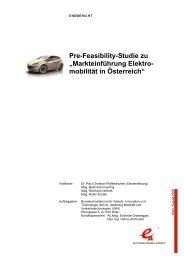Schriftenreihe .;technologiekompetenz Verkehr in
Schriftenreihe .;technologiekompetenz Verkehr in
Schriftenreihe .;technologiekompetenz Verkehr in
You also want an ePaper? Increase the reach of your titles
YUMPU automatically turns print PDFs into web optimized ePapers that Google loves.
CURRENT STATE OF TECHNOLOGY<br />
The great potential for electric vehicles derives from the<br />
possibility of reduc<strong>in</strong>g dependency on fossil fuels and<br />
significantly <strong>in</strong>creas<strong>in</strong>g the efficiency of the drivetra<strong>in</strong>. Electric<br />
drives have a far higher level of efficiency than drivetra<strong>in</strong>s with a<br />
conventional combustion eng<strong>in</strong>e. Given the current state of the<br />
technology, however, these key advantages are set aga<strong>in</strong>st<br />
certa<strong>in</strong> disadvantages, such as poor range, high <strong>in</strong>itial cost and<br />
safety aspects of the energy storage systems (table 1).<br />
Constra<strong>in</strong>ts imposed by the requirements of the electric vehicle<br />
concept, especially regard<strong>in</strong>g the battery storage system,<br />
prevented the enter<strong>in</strong>g of this technology <strong>in</strong>to the mass market<br />
so far. The outcome of past electric vehicle developments<br />
ma<strong>in</strong>ly resulted <strong>in</strong> special applications not suitable for the mass<br />
market. Current applications range from scooters over vehicles<br />
for handicapped people to micro cars with restricted space and<br />
drive range. All of these are more or less only suitable for<br />
special tasks and needs, not be<strong>in</strong>g able to compete <strong>in</strong> the<br />
dom<strong>in</strong>ant vehicle segments with large sale figures. The trend<br />
nevertheless shows that manufacturers are try<strong>in</strong>g to enter the<br />
mass market with competitive electric vehicles. Although<br />
manufacturers are quite cautious with forecasts at the moment,<br />
customers can expect competitive electric or partially electric<br />
vehicles <strong>in</strong> the forthcom<strong>in</strong>g years. Fleet demonstrations like for<br />
<strong>in</strong>stance those <strong>in</strong> London, Berl<strong>in</strong> or Munich as well as larger<br />
scale projects like the project „better place“ will support the<br />
market <strong>in</strong>troduction of electric vehicles with considerably higher<br />
sales figures.<br />
Advantages of electric vehicles<br />
• CO 2-neutral system by us<strong>in</strong>g renewable energy<br />
• High energy efficiency<br />
• Low operat<strong>in</strong>g costs<br />
• Low-noise propulsion system<br />
• Exist<strong>in</strong>g power supply grid<br />
• No emission of pollutants at the place of vehicle operation<br />
Table 1: Advantages and requirements for future-proof electric vehicles<br />
TECHNOLOGICAL CHALLENGES<br />
ELECTRIC VEHICLES<br />
The ma<strong>in</strong> focus <strong>in</strong> the development of EVs rema<strong>in</strong>s <strong>in</strong><br />
maximis<strong>in</strong>g range, performance and safety, while m<strong>in</strong>imis<strong>in</strong>g<br />
weight and cost. To that end, it is necessary on the one hand to<br />
consider the electrical drive, compris<strong>in</strong>g the electric mach<strong>in</strong>e,<br />
the converter, the controller and the energy storage unit, as a<br />
total system and to develop highly optimised <strong>in</strong>dividual<br />
components <strong>in</strong> accordance with these system requirements.<br />
Often the <strong>in</strong>dividual components are configured for maximum<br />
performance, with the ability of the <strong>in</strong>dividual components to<br />
cope with overload mostly not be<strong>in</strong>g taken <strong>in</strong>to consideration,<br />
generally result<strong>in</strong>g <strong>in</strong> over-dimension<strong>in</strong>g, higher costs and<br />
greater weight <strong>in</strong> the overall system. For that reason, <strong>in</strong> order to<br />
achieve ideally configured components, the overall system <strong>in</strong><br />
the vehicle <strong>in</strong>clud<strong>in</strong>g all relevant components and their reciprocal<br />
dependencies needs to be considered as the start<strong>in</strong>g po<strong>in</strong>t <strong>in</strong><br />
develop<strong>in</strong>g the <strong>in</strong>dividual components. On this basis, a key step<br />
can also be taken towards optimis<strong>in</strong>g energy management and<br />
the control system.<br />
The core component of an electric vehicle is the energy storage<br />
system, s<strong>in</strong>ce it def<strong>in</strong>es the range and performance of the<br />
vehicle, but, at the same time, it is the biggest challenge for<br />
further improvements of the overall vehicle.<br />
In recent years, nickel-metal hydride (Ni-MH) and above all new<br />
lithium-ion (Li-ion) cells have established themselves as very<br />
high-performance batteries which already possess sufficient<br />
energy density and are thus ready for series applications (figure<br />
2). At the same time, further improvements <strong>in</strong> Li-ion batteries<br />
are needed with regard to weight, costs and especially safety, <strong>in</strong><br />
order to establish them as an alternative technology for hybrid<br />
and electric vehicles.<br />
Requirements of electric vehicles for broad market penetration<br />
• Ensur<strong>in</strong>g adequate drive range<br />
• Safety of the energy storage system<br />
• Widespread availability of the charg<strong>in</strong>g <strong>in</strong>frastructure<br />
• Acceptable charg<strong>in</strong>g times for the energy storage system<br />
• Innovative design<br />
• Use of renewable energy resources to provide electrical energy<br />
• Reduction of high <strong>in</strong>itial cost for energy storage device<br />
19

















